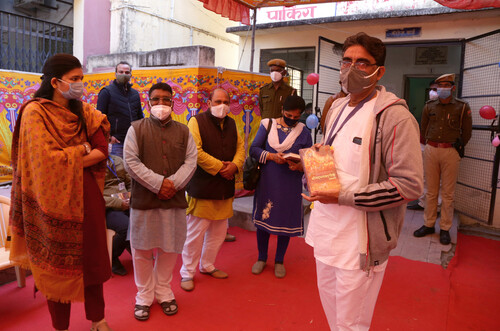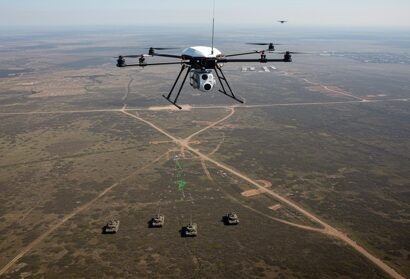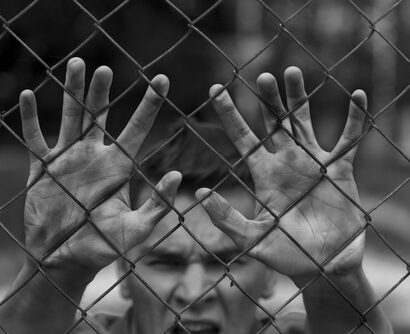Abstract: Along with opportunism and realism, India’s traditions and culture still strongly influence its foreign policy decisions. India invokes certain strands from its past to legitimize its policy decisions. This approach has given India a new rhetoric to shape the new world order in the post-pandemic era. But unless these initiatives are backed up by hard power projection and being involved in an active role in solving the world’s problems, India may not be able to achieve its goal of becoming a regional superpower.
Problem statement: How has India’s Vaccine Diplomacy helped it boost its soft power projection in its international relations?
So what?: In the coming decades, India will have to take on a leading role in resolving the non-traditional security challenges in the Indian subcontinent. India will then be in a position to leverage the capabilities earned through these initiatives for furthering its national interests in the region. In doing so, India may face stiff resistance from Chinese overtures in the region.
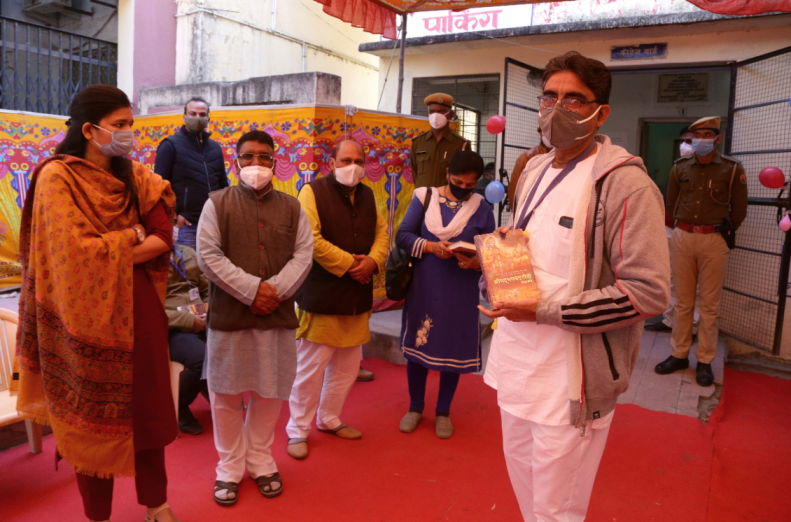
Source: shuttersock.com/Sumit Saraswat
India and the Interconnected World
The ancient Sanskrit phrase of vasudhaiva kutumbakam (the whole world is one family) gets invoked many times when discussing the sources of Indian foreign policy motivations and behavioural patterns. Derived from an ancient Sanskrit shloka, these lines reflect the inclusivity and a broad-minded understanding of an interconnected world, in ancient India.
These traditions give out an important lesson for today’s world – to create something that benefits the whole of humankind, by realizing that, the wellness of the individual, lies in the wellness of everyone else. This understanding has been reflected in India’s handling of the coronavirus pandemic, especially at the international level, as India’s “vaccine diplomacy” received broad acknowledgement, winning accolades for showing a rarely seen maturity on the part of nation-states in times of crisis.
Most nations in the world were badly affected by the coronavirus, lacked the technical knowledge and funds to make a vaccine, and were totally at the mercy of vaccine suppliers, with some countries not even in a position to buy the doses at market prices. This presented a window of opportunity for India to step in and fill up the huge vacuum created in international politics.
What is Vaccine Diplomacy?
Vaccine diplomacy is the use and/or delivery of vaccines to improve a country’s diplomatic relations with other countries. Vaccine diplomacy forms a small subset of healthcare diplomacy or medical diplomacy.Though the term ‘vaccine diplomacy’ is being used popularly today, the phenomenon has existed for centuries. Countries have exchanged medical devices and professionals, treatment procedures, healthcare texts, and other materials in times of crisis. Ancient travellers and authors have also written extensively about healthcare practices in certain regions.[1] Nation-states engage in such activities to support and further their foreign policy goals, since a healthcare emergency affects people of all classes across all borders.
Vaccine diplomacy is the use and/or delivery of vaccines to improve a country’s diplomatic relations with other countries.
The capability mismatch to fight the pandemic created opportunities for some nations and dependency for others. Vaccines were used as a bargaining tool by some countries to further their national interests. Vaccines acquired a hallowed status as it was realized that the timely vaccine shot can lower the chances of the virus infecting the human body. The global pharma industry had a golden opportunity to reap huge benefits from the pandemic; nonetheless, some countries, like India, were able to balance this out by not losing sight of public welfare.
India soon realized that every nation could not counter this virus effectively, and, therefore, collaboration could be the only solution. This is where a strong diplomatic effort came into play, as the domestic needs of all countries got directly connected to their foreign policies – the virus could be countered only with the help of fellow nations, and being isolated would have only backfired.
Role of the Government of India in Vaccine Maitri
India’s vaccine aid initiative was officially named ‘Vaccine Maitri’ by the government; ‘Maitri’ being the Devanagari word for ‘friendship’. The government designated important authorities, such as the All India Institute of Medical Sciences, Health Ministry, and Indian Council of Medical Research, as the nodal agencies to manage the pandemic management process. Since the Prime Minister’s Office was directly involved, the process was planned in a nuanced manner. The central government managed the macro level activities: accepting and analyzing requests for vaccine supply by foreign countries, allocating funds, and discussing solutions with vaccine makers, among others.[2]
Had the curfews and movement restrictions not been in place, India’s vaccine aid to other countries would not have been possible due to heavy domestic demands. The government also rolled out mechanisms to update important statistics for public information via websites and mobile applications. The CoWIN web portal became significant in this context, as reports mentioned that around 76 nations had shown interest in using this technology.[3] The Indian government also announced that this platform would be available free of cost to all such nations. This project set a benchmark as a one of its kind digital health initiative in the world.
The Indian government also announced that this platform would be available free of cost to all such nations. This project set a benchmark as a one of its kind digital health initiative in the world.
The Indian Armed Forces, police, railways and paramilitary forces were also deployed at several places to provide necessary medical support. Foreign nationals staying in India were also allowed to be supported by these systems.[4]
This gesture of the Indian government can be seen as a step to enhance its image in the eyes of foreign citizens. People-to-people connections form an important part of the ‘soft power’ of any nation, and the image of a particular nation in the minds of foreign citizens goes a long way in shaping public perception.
Another important step was to bring back Indian citizens from foreign countries. Thousands of flights were deployed to carry out ”one of the largest evacuation operations in the world”.[5] Ships of the Indian Navy ferried back Indian and foreign nationals. They also carried food, water, medicines and vaccines to the recipient countries.[6] This large-scale evacuation also included sending foreign citizens back to their respective countries. These missions helped increase India’s regional soft power.[7]
Such operations were speedily supported by the respective foreign countries, which realized India’s potential to supply vaccines when needed. This is where hard power gets connected to soft power – if a nation has sufficient problem-solving capabilities, it can find its way through other problems in international politics. Capability development and projection in times of need, are therefore, important elements of comprehensive national power.
India’s foreign collaborations helped speed up the vaccine research when the genome sequencing of the virus was completed.[8] The vaccines were almost ready when the first pandemic wave struck India in early 2021. The world had been closely watching the vaccine research. As India could manufacture billions of doses at a high quality but lower prices, it was obvious that India would be contacted for vaccine supplies.
India’s foreign collaborations helped speed up the vaccine research when the genome sequencing of the virus was completed.
As per the official sources, till May 19 2023 , India had supplied vaccines to 101 countries, in three categories, all numbers are in millions:[9]
– Grants: 15,127,000 – Commercial: 230,869,800 – Covax: 52,027,000 – Total: 298, 023,800
Grants Category
The vaccines under this category were given free of cost to the recipient countries. The initial packages under the grants or gifts category were only provided to countries in India’s neighbourhood. This happened just four days after India started its vaccination program.[10]
This was a symbolic step that indicated India’s geopolitical priorities. India’s extended neighbourhood was the second zone to receive vaccines under grants supply.
Commercial Supplies
Vaccines under this category were mostly exported at market prices, to cover the production costs for the vaccine manufacturers and the costs incurred on vaccine supply to the host nation. Even then, made-in-India vaccines cost much less than those made in the USA. Vaccines in the USA were reported to have been priced at 12-15 dollars per dose, while the Covishield vaccine made by Serum Institute of India was priced at 225 rupees or 2.96 dollars, as of April 2022.[11]
COVAX Supplies
COVID-19 Vaccines Global Access (COVAX) is an international collaborative effort, joined by 184 countries, vaccine manufacturers, vaccine researchers and global bodies like UNICEF, to ensure equitable vaccine distribution globally. India joined this alliance in 2020 as it has an extensive vaccine manufacturing capacity. India benefitted from exporting vaccines to this global alliance which were then sent out to other nations. On the other hand India received around 10 million vaccine doses from COVAX in the year 2021.[12] Thus, this partnership proved beneficial to India during the pandemic. The vaccines supplied by India are Covovax, Nuvaxovid, Sputnik Light, Covaxin, and Covishield.
It can be assessed that India follows a policy of ‘first among equals’ when it comes to its neighbourhood. This can be understood as: even though all of India’s neighbouring countries are the ‘first layer of priority’ for Indian foreign policy, certain nations in the neighbourhood are assigned a greater priority than others. For example, countries like Bhutan and Maldives got the top priority in Vaccine Maitri.[13] Both these countries have taken pro-India stance on issues like Jammu & Kashmir and have been supportive of Indian positions at international forums. No surprises therefore that India gives huge grants and aid to these nations.
Conflict-affected nations, like Afghanistan and Myanmar, where many stakeholders have to be balanced out before intervening, came next on the priority list. Finally, relatively stable nations like Nepal and Bangladesh came last. Bhutan and Maldives were the first batch of nations to receive vaccine supplies from India, just four days after India started (on 20 January 2021) its domestic vaccination program. Nepal, Bangladesh, Myanmar, and Seychelles were the second tier of nations to receive Made-in-India vaccines. Keeping up its traditions of supporting the United Nations (UN), India also donated 200,000 vaccines in one go, to the UN Peacekeeping Forces (PKF) (Current Strength of UN PKF: 202,512).
Pakistan was not supplied vaccines by India directly, as the Pakistani government did not request supplies. However, Pakistan received 45 million doses of the Indian-made Covishield vaccine from the COVAX alliance, as grants. India neither objected to this, nor placed any terms and conditions in front of the COVAX authorities, despite its strained political relations with Pakistan.[14] The vaccines were directly transported from India to Pakistan. It must be mentioned here that, though bilateral trade has been suspended since 2019, essential medicines and other life-saving goods were exempted from this trade ban.
Pakistan received 45 million doses of the Indian-made Covishield vaccine from the COVAX alliance, as grants.
The following table presents the country-wise vaccines supplied to India’s neighbouring countries, and the UNO teams, as of 19 May 2023. All numbers are in millions:[15]
Vaccine Supplies to the Indian Neighbourhood Countries
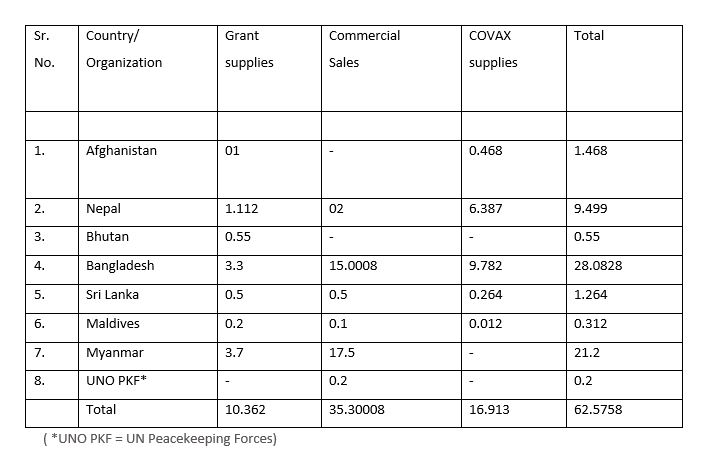
India was also the first country to hold a multilateral summit with SAARC (South Asian Association for Regional Cooperation) members in the early days of the pandemic, which inspired other multilateral bodies to come together and cooperate on the issue.[16]
Another notable aspect of India’s vaccine diplomacy was the proactive launch of a dedicated pandemic section, on the website of the SAARC Disaster Management Centre. The website has all the relevant statistical data, external links to health ministries of SAARC countries, and global healthcare bodies, and a social media updates section to provide real-time data to users. It also has a dedicated section to nation-wise best practices to be followed in pandemic management.
All these events benefitted Indian foreign policy in two ways:
- India reinforced its massive pharmaceutical production and delivery capabilities. The ability to make millions of vaccine doses and supply them in a time-bound manner, taking into consideration the delivery time, supply requests, preserving the vaccines, logistical arrangements tested and proved India’s resilience.
- Vaccine Diplomacy also established India as the ‘first responder’ in times of crisis, especially in its immediate neighbourhood. It gave India an enhanced reputation as a benevolent regional power.
India’s timely vaccine supplies helped countries like Bhutan vaccinate almost their entire population within a few weeks.[17]
A preliminary analysis of media coverage given to India’s Vaccine Maitri in the host countries pointed towards a favourable public opinion for India. In many countries, the aircraft of the Indian Air Force and ships of the Indian Navy were used to deliver the vaccines as soon as possible. This showcased the soft power of the nation, with its armed forces being used for purely humanitarian purposes.
A preliminary analysis of media coverage given to India’s Vaccine Maitri in the host countries pointed towards a favourable public opinion for India.
Soft-Power Signalling by Use of Particular Terminologies
It is important to note how soft power elements were used in how the vaccine consignments were packed and delivered. The vaccines were packaged in white packages, which carried the flags of India and the host country (which indicates bilateral solidarity).[18] But what stood out were the messages imprinted on the outer side of these packs. The consignments carried the message in a clear legible font: “A gift from the people and government of India”.[19]
It must be mentioned here, that “the people of India” is the starting line of the Preamble of the Indian Constitution; it is the people of India– in whose hands lies the power of ultimate authority of ruling the Indian nation. The symbolic message here was that the vaccines have been sent to the host nation, by the people of India, by their own will. The government of India has just facilitated this support. This can be co-related to the previously mentioned tradition of ‘vasudhaiva kutumbakam’ – the world is seen as one big family, of which nations are members, and one family member helps the other in times of crisis.
It once again underlined the Indian sentiment of helping the members of the global family. When India announced its Vaccine Maitri initiative, surprisingly, there was no resistance or protest from any section of the Indian society in opposition to this decision of the Government of India. The citizens of India seemed to be in an unvoiced agreement with the official decision to supply vaccines to foreign countries, even before the first round of domestic vaccination was completed. Bharat Biotech’s Covaxin packages carried the message in Devanagri script: ‘Sarve santu niramayaha’ – may all be free from diseases.[20]
The word ‘Vaccine Maitri’ literally translated as ‘Vaccine Friendship’ were also printed on the consignments.[21] Putting these lines on the vaccine packages was a subtle way of signalling ancient traditions and their relevance in the present situation. This symbolised that Vaccine Maitri is not just an act of policy by the Government of India, but a ‘gift’ from the people of India for the people of the host country to help them deal with the tough times of the pandemic.
Also, the term “Made-in-India” was used in all official communications and media reporting for the vaccines. This seemed to be a cautious approach, as although Oxford University and AstraZeneca originally did the vaccine research, India produced the vaccines under license, due to its massive production capacity. Therefore, using the above terminology saved India from any unnecessary controversy or copyright issues that may have erupted from terming the vaccines as “Indian vaccines”.
India not just supplied the vaccines but also the supporting materials like deep freezers, syringes, bottles, trained medical staff, technical knowledge manuals and PPE kits.[22] Thus, it was not just the vaccines but a comprehensive packaged solution that host countries received.
The term “Made-in-India” was used in all official communications and media reporting for the vaccines. This seemed to be a cautious approach, as although Oxford University and AstraZeneca originally did the vaccine research, India produced the vaccines under license, due to its massive production capacity.
Effective Use of Print, Electronic, and Social Media
In one of the official programs in which the vaccines were handed over to Bangladeshi officials, the organizers displayed banners with the message: “Handing over ceremony of 20 lakh doses of Made in India Vaccine from the people of India to the people of Bangladesh”.[23] The right amount of media coverage given to such events in India, as well as in the host country, without any extra show of jingoism or superiority complex, enhanced India’s soft power and public perception. The images and captions of these deliveries, shared by official social media accounts of embassies and ministers and leaders of India and the host countries, helped create an atmosphere of warmth and solidarity. The choice of words for the captions was also very thoughtful.
For example, Indian External Affairs Minister Dr S. Jaishankar tweeted when the first package was sent to Mongolia: “Caring for a spiritual neighbour. Made in India vaccines reach Mongolia”.[24] The Twitter hashtag “#VaccineMaitri” was trending for many weeks on a continuous streak on Twitter, Facebook, and other social media platforms. Foreign citizens, who received the Made-in-India vaccines, were seen posting their pictures online and thanking India, after their first doses.
Balancing International Power-Politics
Globally, governments were in a tight situation – as the number of COVID-19 cases was rising daily, vaccines were not yet ready, and existing medicine stocks were depleting rapidly. On the one hand, even for most of the medicines made in India, the ingredients came from countries like China.[25]
On the other hand, the USA tried to pressurize India for vaccine exports by threatening to stop the supply of raw materials and medicines like Remdesivir.[26] However, India was careful enough to conduct all trials on its population and avoided testing the vaccines on foreign citizens. As the production levels increased after successful clinical trials, some vaccines were diverted as ‘aid’ to foreign countries.[27] It was a test of diplomatic manoeuvering to balance the USA and China while securing the national interests of India.
India was careful enough to conduct all trials on its population and avoided testing the vaccines on foreign citizens.
As foreign vaccine manufacturers were doing, it was necessary to convince the India-based vaccine makers to let the government decide where and how their vaccines will be used, at what prices, and in what quantities. It was also diplomatic manoeuvering for India to keep the foreign vaccine producers at a distance for financial and political reasons. Before vaccine production started, India had supplied food, medicines and PPE kits to many countries and those supply chains were used for sending out vaccines.[28]
The cost factor had its significance here, as it brought out the difference in behaviours of nation-states. While some countries and corporations engaged in hoarding vaccines and increasing export prices,[29] India was careful enough to keep the prices lower.
This put the healthcare narrative in favour of India, as it did not seek to earn profits from this disaster. Thus, India managed to save itself from the tag of “conflict entrepreneur”. The United Nations and the World Health Organisation appeared helpless when dealing with the power politics of states, like the USA and China, as they signed advance pre-purchase agreements with vaccine producers, securing millions of vaccine doses for their people.[30] These contracts were valued at billions of dollars. This phenomenon came to be termed “vaccine nationalism”. India’s Vaccine Maitri stood out in stark contrast to this. India and South Africa put up a collaboration at the WTO to remove patent rights on raw materials required to make the vaccines. Later on, the US also joined this initiative.
Vaccines sent by China to Brazil also got mired in political controversies. Brazil banned the trials of China-made vaccines on the Brazilian population, as it was reported to have an efficiency of only 50 percent.[31] Brazil then requested four million doses of Made-in-India vaccines, which were delivered and administered to their people, without any controversy. India-made vaccines were reported to have one of the highest rates of acceptance globally.[32] While China came to be seen as the ‘problem creator’ in this pandemic, India’s image was one of a ‘solution creator’ and ‘first responder in times of crisis’.
Achievements of Vaccine Maitri
India was able to project its soft power through the way it communicated its help, timely deliveries, and non-discriminatory aid giving. It emerged as the first responder to send medical help during this pandemic. Indian vaccine supply agreements were completely apolitical, without any strings attached. The vaccine aid was not connected with any other political issues, neither was it used as a bargaining tool to sort out any other international problems. This amplified India’s positive public image.
India showed no hesitation in sending vaccines to conflict-prone areas like Afghanistan and Syria. The UNO was able to vaccinate a large number of the Syrian population, which was badly affected by food insecurity and harsh winters, using vaccines sent by India.[33] Vaccine Maitri was carried out without any official or unofficial expectation of reciprocity from the host nations.
The UNO was able to vaccinate a large number of the Syrian population, which was badly affected by food insecurity and harsh winters, using vaccines sent by India.
As first responders, optimum use of all the available data and resources was done and the nation worked as one single unit. India’s vaccine diplomacy was extensively reciprocated by many countries, the Indian diaspora, and other non-state actors from foreign countries during the second corona wave in India when India had to stop all vaccine exports.[34] The Ministry of External Affairs website mentions all the relief equipment that India got as grants from foreign countries during this time[35] without making any official requests for help. This event can be judged as the success of India’s vaccine diplomacy and soft power.
Conclusion
Even though India uses its past heritage to emphasise its present foreign policy decisions, this behaviour is more “correct than consistent”. It is a mix of pragmatism and opportunism based on lessons derived from ancient traditions and practices that give it a moral legitimacy.
The pandemic has also highlighted the fact that, in the coming decades, India will have to use many of its resources to tackle non-traditional security challenges like access to healthcare for all citizens and increasing the availability of food and medicines, among other issues. The overall pandemic management in India has shown that foreign policy goals can be achieved only when the nation is internally strong and efficient. It is the internal national strength, projected outward as a comprehensive national power, which India should look to develop at a faster rate.
India should strive to become a benevolent regional power, rather than aiming for global leadership. The goodwill earned by Vaccine Maitri should be used as a platform to leverage India’s capabilities. As the post-pandemic world will be increasingly multi-polar, India will have to focus on its economic growth, enhancing issue-based multilateral and plurilateral partnerships, and achieving sustainable development. Therefore, India should take on a leadership role in South Asia with respect to sustainable development and non-traditional security challenges. This will pave the way forward for India to emerge as a dominant regional power in this part of the world.
India should take on a leadership role in South Asia with respect to sustainable development and non-traditional security challenges.
“Vasudhaiva Kutumbakam” will thus have to be achieved, in letter, and spirit, in the modern-day context as a part of reformed multilateralism, since this is the kind of an all-inclusive approach that the world needs in a post-pandemic world. In this way, India can help propel the world into an orbit of a sustainable and inclusive future for all members of the world family.
Wankhede Rahul Bhojraj is a research scholar at the JNU Special Centre for National Security Studies. He previously worked as an assistant professor at Savitribai Phule Pune University. His previous publications include web articles, book chapters and journal articles. The views contained in this article are the author’s alone.
[1] S.A. Tabish, “Historical Development of Health Care in India,” 23–28.
[2] “India’s Vaccine Maitri- A Unique Friendship by Jabs,” February 22, 2021, https://www.vifindia.org/article/2021/february/22/india-s-vaccine-maitri-a-unique-friendship-by-jabs.
[3] “India Coronavirus Dispatch: 76 Countries Express Interest in CoWin | Business Standard News,” n.d., last accessed December 05, 2022, https://www.business-standard.com/article/current-affairs/india-coronavirus-dispatch-76-countries-express-interest-in-cowin-121070500537_1.html.
[4] “Foreign Nationals Are Now Eligible for Vaccination in India,” n.d. accessed June 05, 2023, https://www.pib.gov.in/www.pib.gov.in/Pressreleaseshare.aspx?PRID=1744146.
[5] “Three Decades before Covid, India Conducted the Largest Civilian Evacuation in History,” n.d. accessed June 05, 2023, https://theprint.in/india/three-decades-before-covid-india-conducted-the-largest-civilian-evacuation-in-history/416095/.
[6] A. Kupriyanov, “‘Soft Power’ of the Indian Navy in the Pandemic Era,” Analysis and Forecasting, IMEMO Journal 4 (4): 40–51, https://doi.org/10.20542/afij-2020-4-40-51.
[7] Rubul Patgiri, Rahul Kumar, and Sanjeev Kumar, “COVID-19 Pandemic and India’s Regional Soft Power Diplomacy,” Journal of Polity and Society, 14 (1), https://journalspoliticalscience.com/index.php/i/article/view/8.
[8] “One Million Coronavirus Sequences: Popular Genome Site Hits Mega Milestone,” n.d., last accessed December 05, 2022, https://www.nature.com/articles/d41586-021-01069-w.
[9] “Vaccine Supply,” n.d. last accessed June 06, 2023, https://www.mea.gov.in/vaccine-supply.htm.
[10] “India Resumes Vaccine Maitri Initiative: All about the Programme and Why It Was Paused for 7 Months,” n.d. accessed June 05, 2023. https://www.firstpost.com/india/india-resumes-vaccine-maitri-initiative-all-about-the-programme-and-why-it-was-paused-for-7-months-10143111.html.
[11] “Serum Institute Cuts Price of Covishield to Rs 225 per Dose – BusinessToday,” n.d. last accessed December 05, 2022, https://www.businesstoday.in/coronavirus/story/covid-19-vaccination-covishield-covaxin-price-cut-to-rs-225-per-dose-329270-2022-04-09.
[12] “India Received One-Third of Vaccines Made for Poor Countries by India under COVAX Programme: Report,” n.d. India Today, accessed June 24, 2023, https://www.indiatoday.in/coronavirus-outbreak/vaccine-updates/story/india-received-one-third-of-vaccines-made-for-poor-countries-by-india-under-covax-programme-report-1785242-2021-03-30.
[13] “Bhutan, Maldives First among 6 Recipients of Covid Vaccine from India,” n.d. India Today, last accessed November 27, 2022, https://www.indiatoday.in/coronavirus-outbreak/story/bhutan-maldives-first-among-6-recipients-of-covid-vaccine-from-india-1760843-2021-01-20.
[14] The Times of India, “Pakistan Set to Get 45 Million India-Made Doses,” March 10, 2021, https://timesofindia.indiatimes.com/world/pakistan/pakistan-set-to-get-45-million-india-made-doses/articleshow/81422619.cms.
[15] “Vaccine Supply,” n.d. last accessed June 06, 2023, https://www.mea.gov.in/vaccine-supply.htm.
[16] “SAARC’s Resurrection: Leadership in the Time of COVID-19 – Indian Council of World Affairs (Government of India),” n.d. last accessed December 05, 2022, https://www.icwa.in/show_content.php?lang=1&level=3&ls_id=4651&lid=3503.
[17] “At UNGA, Bhutan, Nepal Express Gratitude for India’s Supply of COVID-19 Vaccines | India News, The Indian Express,” n.d. accessed June 05, 2023, https://indianexpress.com/article/india/unga-bhutan-nepal-gratitude-indias-supply-covid-19-vaccines-8174959/.
[18] “India Unlikely to Resume ‘Vaccine Maitri’ for Neighbours before July,” April 29, 2021, sec. India. https://www.thehindu.com/news/national/india-unlikely-to-resume-vaccine-maitri-for-neighbours-before-july/article34443080.ece.
[19] “Sreeram Chaulia l Vaccine Diplomacy Is India’s Finest Hour,” n.d. accessed June 05, 2023, https://www.asianage.com/opinion/columnists/290121/sreeram-chaulia-l-vaccine-diplomacy-is-indias-finest-hour.html.
[20] Idem.
[21] Idem.
[22] “India Exported 23 Lakh PPE Kits to 5 Countries in July: Health Ministry | Deccan Herald,” n.d. accessed June 05, 2023, https://www.deccanherald.com/national/india-exported-23-lakh-ppe-kits-to-5-countries-in-july-health-ministry-873251.html.
[23] India in Bangladesh [@ihcdhaka], “From the People and Government of 🇮🇳 to the People and Government of 🇧🇩 Gift of 2 Million Made-in-India Covid-19 Vaccine Handed over by HC @VDoraiswami to Hon’ble Foreign Minister H.E.Dr.AKA Momen & Hon’ble Health Minister H.E.Zahid Maleque #VaccineMaitri #NeighbourhoodFirst Https://T.Co/LZxzxSUaEf,” Tweet, Twitter, https://twitter.com/ihcdhaka/status/1352176527362822145.
[24] Dr. S. Jaishankar [@drsjaishankar], “Caring for a Spiritual Neighbour. Made in India Vaccines Reach Mongolia. #VaccineMaitri Https://T.Co/8wIRImXX7D,” Tweet, Twitter, https://twitter.com/drsjaishankar/status/1363712034337034241.
[25] “China Supplies over 80% of Pharma Raw Materials – Times of India,” n.d. accessed June 09, 2023, https://timesofindia.indiatimes.com/business/india-business/china-supplies-over-80-of-pharma-raw-materials/articleshow/76453541.cms.
[26] “India Hopes U.S. Will Soon Ease Ban on Vaccine Material Exports – Sources | Reuters,” n.d. accessed June 09, 2023, https://www.reuters.com/business/healthcare-pharmaceuticals/india-hopeful-us-will-soon-end-curbs-vaccine-raw-materials-export-govt-sources-2021-04-19/.
[27] “India Starts Donating Covid-19 Vaccines to Neighboring Countries – WSJ,” n.d. accessed June 09, 2023, https://www.wsj.com/articles/india-starts-covid-19-vaccine-drive-to-neighboring-countries-11611234933.
[28] “Useful Articles : India’s Response to Pandemic: Using Crisis as an Opportunity,” n.d. accessed June 09, 2023, https://eoi.gov.in/kabul/?11227?000.
[29] “Vaccine Diplomacy versus Vaccine Nationalism: Synthesis or Dissonance?,” n.d. accessed June 09, 2023, https://www.carnegiecouncil.org/media/article/vaccine-diplomacy-versus-vaccine-nationalism-synthesis-or-dissonance.
[30] “Rich Countries Cornered COVID-19 Vaccine Doses. Four Strategies to Right a ‘scandalous Inequity’ | Science | AAAS,” n.d. accessed June 09, 2023, https://www.science.org/content/article/rich-countries-cornered-covid-19-vaccine-doses-four-strategies-right-scandalous.
[31] “Brazil Suspends Chinese-Made COVID-19 Vaccine Trials – The Hindu,” n.d., last accessed December 05, 2022, https://www.thehindu.com/news/international/brazil-suspends-chinese-made-covid-19-vaccine-trials/article33063832.ece
[32] “Building Confidence in the COVID-19 Vaccine in India | UNICEF India,” n.d., last accessed December 05, 2022, https://www.unicef.org/india/stories/building-confidence-covid-19-vaccine-india.
[33] “Syria Receives Its First Delivery of COVID-19 Vaccines through the COVAX Facility,” n.d., last accessed December 05, 2022, https://www.unicef.org/mena/press-releases/syria-receives-its-first-delivery-covid-19-vaccines-through-covax-facility.
[34] The Hindu, 2021a, “Aid Pours in from the World to Counter India’s COVID-19 Second Wave,” April 27, 2021, sec. India, https://www.thehindu.com/news/national/us-leads-international-support-to-enable-india-counter-the-covid-19s-deadly-second-wave/article34424416.ece.
[35] “Fight Against COVID19,” n.d. accessed June 09, 2023, https://www.mea.gov.in/fight-against-covid-19.htm.


